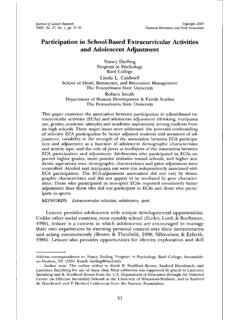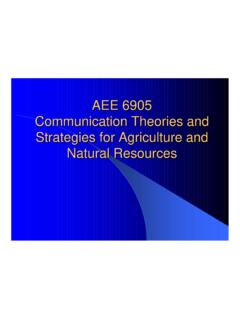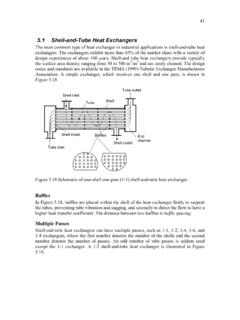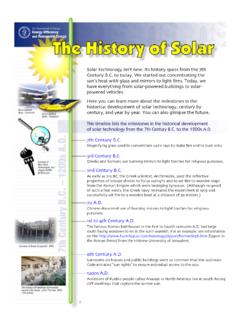Transcription of Calculating Heat - University of Florida
1 Worksheet 17 1 Worksheet #17 Calculating heat 1. How much heat is needed to bring g of water from C to C, if the specific heat capacity of water is J/(g C)? 2. How much heat is released when 143 g of ice is cooled from 14 C to 75 C, if the specific heat capacity of ice is J/(g C). 3. When 137 mL of water at 25 C is mixed with 82 mL of water at 76 C, what is the final temperature of the water? Assume that no heat is lost to the surroundings and that the density of water is g/mL. 4. An unknown volume of water at C was added to mL of water at C.
2 If the final temperature was C, what was the unknown volume? Assume that no heat is lost to the surroundings and that the density of water is g/mL . Determining Specific heat Capacity 5. An alloy of unknown composition is heated to 137 C and placed into g of water at C. If the final temperature of the water was C, and the alloy weighed g, what is the specific heat capacity of the alloy? The specific heat of water is J/g C. 6. A g rock is heated to C and placed into g of water originally at C. If the final temperature of the water was C, what is the specific heat capacity of the rock?
3 7. Given that the specific heat of gold is J/g C, calculate the final system temperature if a g block of gold at C is placed in a coffee-cup calorimeter containing g of water at an initial temperature of C. 1. How many calories are needed to raise the temperature of exactly 500 g of water from C to C? 2. How many joules are released when mL of chloroform cool C? The s pecific heat of chloroform is J/(g)( C) and its density is g/mL. 3. The specific heat of benzene is J/(g)( C). Suppose that you have a 200 g sample of benzene at C and remove kJ.
4 What does its temperature become? 4. Determine the specific heat of Cu from the fact that J are needed to raise the temperature of g of Cu metal from C to C. Calculate q when g of water is heated from 20. C to 100. C. Worksheet 17 2 A 295-g aluminum engine part at an initial temperature of C absorbs kJ of heat . What is the final temperature of the part (c of Al = J/g K)? Two iron bolts of equal mass one at 100. C, the other at 50 C are placed in an insulated container. Assuming the heat capacity of the container is negligible, what is the final temperature inside the container (c of iron = J/g K)?
5 When 165 mL of water at 22 C is mixed with 85 mL of water at 82 C, what is the final temperature? (Assume that no heat is lost to the surroundings; d of water is g/mL.) A 505-g piece of copper tubing is heated to C and placed in an insulated vessel containing g of water at C. Assuming no loss of water and a heat capacity for the vessel of J/K, what is the final temperature of the system (c of copper = J/g K)? Answers to Worksheet # 17 Calculating heat The specific heat capacity (c) of a substance is the amount of heat required to raise the temperature of 1 gram of a substance by 1 K.
6 Units are in J/g K or J/g C. The molar heat capacity (C) of a substance is the amount of heat required to raise the temperature of 1 mole of a substance by 1 K. Units are in J/mol K or J/mol C. To calculate heat , remember that q = mc T, where T = Tfinal Tinitial. 1. T = C C = C ( ) ( ) 783 heat is absorbed by the = = = 2. T = -75 C 14 C = -89 C (143 ) ( 89)27, 00027 heat is released by the = = = = 3. qsys + qsurr = 0, )( )(==== (137 ) (25) (82 ) (76) 0ffJJgTCgTCgCgC + = 57314330343260750ffJJTJT JCC + = Worksheet 17 3 === 4.
7 (== 0) ( ) () ( )(= + CCgJgCCCgJX () g = = === Determining Specific heat These problems are based on the fact that qsys + qsurr = 0. Note that the final temperature of the system and the surroundings has to be the same. 5. The system is the alloy, and the surroundings are water. Tsys = C 137 C = -101 C Tsurr = C C = C ( )( 101) ( ) ( ) 0sysJgcCgCgC + = + = == 6. The system is the rock and the surroundings are water. Tsys = C C = C Tsurr = C C = C 0) ( ) () () (= + CCgJgCcsys + = == 7.)
8 The system is gold and the surroundings are water. ( ) ( ) ( ) ( ) ( )209( ) TJCCJJTJTCJCC + = + = + += === Worksheet 17 4 1. ? cal 500 g water=1cal(g water )( C C) 31275 cal 10 cal== [ T = C C = C] 2. 3? mL CHCl= g CHCl 33mL J(gCHCl ( C)786 J)( C) = 3. ( g benzene?C1463 JT=? = )( C) g benzene C Tfinal = Tinit + T = 45 C - C = C 4. ? JSpecific heat (gram Cu)( C)( g Cu)( C)(gram Cu)( C)== = [ T = C C = C] 5.
9 ? kcal g water=mole water g kcalmole water kcal= Plan: The heat required to raise the temperature of water by 80. C is found by using equation , or q = c x mass x T. The specific heat capacity, cwater, is found in Table Because the Celsius degree is the same size as the kelvin degree, T = 80. C = 80. K. q(J) = (mass) C ( T) = ()()() CgC = = x 103 J q(J) = (mass) C ( T) kJ(103 J/kJ) = (295 g) ( J/g C) (Tf - ) C (Tf - ) C = ()()310 J295 ggC = C (unrounded) Tf = 323 C Since the bolts have the same mass, and one must cool as the other heats, the intuitive answer is [(T1 + T2) / 2] = C.
10 Use the same procedure in , but mass is now a factor because the two water samples are not identical. Both volumes are converted to mass using the density ( , 85 mL x g/mL = 85 g). Convert C temperatures (22 C, 82 C) to Kelvin temperatures (295 K, 355 K). -qlost = qgained - [85 mL ( g/mL)] ( J/g C) (Tf - 82) C = [165 mL ( g/mL)] ( J/g C) (Tf - 22) C Worksheet 17 5 - [85](Tf - 82) = [165] (Tf - 22) 6970 - 85 Tf = 165 Tf - 3630 6970 + 3630 = 165 Tf + 85 Tf 10600. = 250. Tf Tf = (10600. / 250.) = = 42 C Plan: heat gained by water plus heat lost by copper tubing must equal zero, so qwater = -qcopper.











